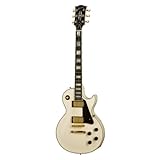
Average Reviews:

(More customer reviews)A great sounding and playing guitar, but I had a similar experience to another reviewer here. The guitar tipped out of the stand, and the headstock completely snapped off. I managed to fix it, but the paint job is permanently damaged and it was a pretty heart-breaking moment to see the guitar destroyed like that. And no, Gibson will not cover this sort of damage, even though the break occurred on an obvious knot in the hardwood - a production flaw that should not occur on a guitar in this price range.
Click Here to see more reviews about: Gibson Les Paul Custom Electric Guitar, Alpine White
The introduction of the Les Paul Model in 1952 provided the fundamental template for the design of what would eventually become the most revered stringed instrument in the world. Today's Les Paul Custom is based on the model from the mid-1950s, but with several modern appointments.
The Incomparable Les Paul Custom Guitar
HistoryThe introduction of the Les Paul Model in 1952 provided the fundamental template for the design of what would eventually become the most revered stringed instrument in the world. Yet Gibson president Ted McCarty and the guitar's namesake, Les Paul, also sought to introduce a "deluxe" version of the soon-to-be iconic model. The final design for the new Les Paul Custom was completed in early 1954, and the guitar made its official debut at the Chicago NAMM show in July 1954.
Initially, the goal had been to introduce the "deluxe" version in conjunction with the original 1952 Les Paul, yet Gibson's drive to achieve excellence resulted in several unexpected delays. The final product, however, would eventually become Gibson's top model in the original Les Paul line.
The 'Fretless Wonder' The first version of the Les Paul Custom was nicknamed the "Fretless Wonder" for its low frets and "Black Beauty" for its rich, contrasting ebony color. It was also introduced at the same time as the Gibson Les Paul Junior and represented the ultimate in Gibson solid body design at the time, with an original price tag of just $325, which was $100 more than the regular Les Paul Model.
Aside from its obvious visual enhancements, the Les Paul Custom was the first Gibson guitar to offer the revolutionary ABR-1 Bridge, which was invented by McCarty. This pioneering achievement was a true revelation in intonation and remains one of the most revered and copied pieces of guitar hardware ever developed, setting a standard for simplicity and functionality that has never been bettered.
Other standard appointments included a thicker body design and seven-ply body binding on both the front and back of the guitar, along with a multi-bound headstock that featured a prominent five-piece split diamond patterned inlay of genuine mother of pearl--a design that still graces every Les Paul Custom made today.
Near-perfect Recreation Today's Les Paul Custom is based on the model from the mid-1950s, but with several modern appointments. The body of the guitar is crafted with a hand-carved maple top, which is then fitted to a body made from a solid piece of mahogany with strategically routed holes to lessen the weight of the guitar, resulting in a Les Paul with enhanced acoustic qualities and improved resonance. The 24-3/4 inch scale length neck is also made from one solid piece of mahogany then topped by a 22-fret ebony fingerboard outfitted with figured acrylic block inlays, and given Gibson's traditional rounded profile. The pickups are Gibson's 490R in the neck position, which offers the tonal characteristics of the original PAFs, and the 498T in the bridge position, which swaps the 490R's Alnico II magnet for an Alnico V, thus making it slightly hotter with emphasis on mid-ranges and highs.
Other appointments include Gibson's legendary Nashville Tune-o-matic bridge and stopbar tailpiece, metal tulip tuners, multi-ply white and black binding on both the top and back, gold hardware, and a 1 11/16" nut width. The Les Paul Custom is available in Antique White, Ebony, Heritage Cherry Sun Burst, Wine Red and Silver Burst, and each guitar comes with the standard Gibson Custom case, custom care kit, and certificate of authenticity.
Nitrocellulose Finish Applying a nitrocellulose finish to any Gibson guitar is one of the most labor-intensive elements of the guitar-making process. A properly applied nitro finish requires extensive man hours, several evenly applied coats, and an exorbitant amount of drying time. But this fact has never swayed Gibson into changing this time-tested method, employed ever since the first Gibson guitar was swathed with lacquer back in 1894. Why? For starters, a nitro finish dries to a much thinner coat than a polyurethane finish, which means there is less interference with the natural vibration of the instrument, allowing for a purer tone. A nitro finish is also a softer finish, which makes it easily repairable. You can touch up a scratch or ding on a nitro finish, but you can't do the same on a poly finish. In addition, a nitro finish is very porous in nature, and actually gets thinner over time. It does not "seal" wood in an airtight shell--as a poly finish does--and allows the wood to breathe and age properly.
All VOS (Vintage Original Spec) series guitars will use a proprietary process that includes unique steps for staining, wet-sanding, and hand-rubbing; subsequently the guitars reflect what a well-cared for 40-year-old guitar looks like. The result is a remarkable patina that will delight even the most discriminating enthusiast.
Click here for more information about Gibson Les Paul Custom Electric Guitar, Alpine White

0 comments:
Post a Comment